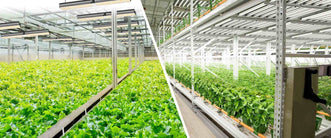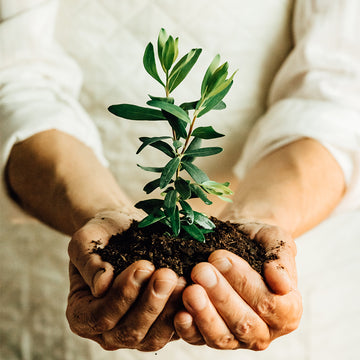The Ultimate Guide to Grow Lettuce Indoors
Are you tired of relying on store-bought lettuce, which often lacks the freshness and flavor of homegrown produce? The good news is that you can grow lettuce indoors year-round, regardless of the weather outside or the size of your living space. With a little bit of planning and some basic equipment, you can enjoy the satisfaction of harvesting your own fresh, crunchy lettuce leaves right from your own home.
In this guide, we will provide you with a step-by-step process on how to grow lettuce indoors, from selecting the right varieties to harvesting your homegrown lettuce. Whether you are a seasoned gardener or a beginner, growing lettuce indoors is a fun and rewarding way to bring some greenery into your home and enjoy a healthy, tasty addition to your meals.
Best Types of Lettuce to Grow Indoors

When it comes to growing lettuce indoors, selecting the right varieties is key to success. Not all types of lettuce are suitable for indoor growing, as some require more space, light, and specific growing conditions than others. Here are some of the best types of lettuce to grow indoors:
Loose-leaf lettuce: Loose-leaf lettuce varieties are a great choice for indoor growing because they don't form heads and can be harvested continuously. They grow quickly and don't need as much space as other lettuce types.
Butterhead lettuce: Butterhead lettuce, such as Bibb or Boston lettuce, is a soft and tender type of lettuce that forms small heads. It is well-suited for indoor growing as it prefers cooler temperatures and moderate light.
Romaine lettuce: Romaine lettuce is a classic type of lettuce that is perfect for indoor growing as it is easy to grow and has a longer growing season than other types. It forms tight heads with crispy, dark green leaves.
Microgreens: Microgreens are a great option for indoor growing, as they are harvested when they are very young and only a few inches tall. They are nutrient-dense and can be grown in a small space.
Arugula: Arugula is a peppery, tangy green that is perfect for adding to salads or sandwiches. It grows quickly and doesn't require as much light as other lettuce types, making it ideal for indoor growing.
Step-by-Step Guide for Growing Lettuce Indoors
Step One: Choose Your Indoor Growing Space

When it comes to growing lettuce indoors, choosing the right indoor growing space is crucial for your plants' success. Lettuce requires adequate light, moderate temperatures, and good air circulation to thrive. Consider choosing a spot near a sunny window or using artificial lighting to provide enough light for your plants. Avoid placing your plants in areas that are too hot or too cold, and make sure the space has good air circulation to prevent moisture buildup and mold growth.
Additionally, consider the size of your growing space and the number of plants you want to grow to ensure that your lettuce has enough room to grow and thrive. By selecting the right indoor growing space, you can set your lettuce plants up for success and promote healthy growth.
Step Two: Modify Growing Conditions
Once you've chosen your indoor growing space and selected a container, it's time to modify the growing conditions to promote healthy lettuce growth. Lettuce requires moderate temperatures, good air circulation, and adequate light. To create the right growing conditions, you may need to adjust factors such as temperature, humidity, and lighting. You may also need to adjust the temperature and humidity levels in the growing space to ensure optimal growing conditions for your lettuce plants. With the right modifications, you can create an ideal growing environment for your indoor lettuce garden.
Step Three: Select a Suitable Container

Selecting a suitable container is an important step in growing lettuce indoors. Choose a container that is large enough to accommodate your lettuce plants and has adequate drainage holes to prevent waterlogging. Consider using pots or containers made of materials like plastic, ceramic, or clay that can hold moisture and provide good drainage. You can also opt for hydroponic setups that allow you to grow lettuce in nutrient-rich water without soil. Whatever container you choose, make sure it fits well in your indoor growing space and provides enough room for your lettuce to grow. By selecting a suitable container, you can ensure that your lettuce plants have a healthy and comfortable home to grow in.
Step Four: Use a Potting Mix for Vegetables

Using a suitable potting mix for vegetables is an important step in growing lettuce indoors. Choose a potting mix that is rich in organic matter and nutrients, and specifically formulated for vegetables or herbs. Avoid using garden soil as it may contain pests or disease-causing microorganisms that can harm your plants. Additionally, make sure the potting mix has good drainage to prevent waterlogging and root rot. You can also consider adding compost or other organic fertilizers to the potting mix to provide your lettuce plants with additional nutrients.
Step Five: Buy Lettuce Seeds or Seedlings
You can purchase lettuce plant seeds or seedlings from a local nursery or garden center or order them online. Consider choosing lettuce varieties that are well-suited for indoor growing, such as butterhead, romaine, or loose-leaf lettuce. When selecting seedlings, choose plants that look healthy and free from pests or diseases. If starting from seeds, make sure to choose high-quality seeds and follow the instructions on the package for optimal germination.
Step Six: Plant Lettuce Seeds at a Shallow Depth

Sow the lettuce seeds at a depth of around 1/4 to 1/2 inch in the potting mix. Make sure to space the seeds at least 2-3 inches apart to provide enough room for the lettuce plants to grow. After planting, cover the seeds with a thin layer of potting mix and gently water them using a mist bottle. Lettuce seeds typically germinate in 7-14 days, depending on the variety and growing conditions. By planting lettuce seeds at a shallow depth, you can help ensure that they receive enough oxygen and moisture to germinate and grow into healthy seedlings.
Step Seven: Water the Seeds with a Mist Bottle
Watering lettuce seeds with a mist bottle is an important step in growing indoors. After planting the seeds, use a mist bottle to gently water the potting mix. Avoid over-watering the seeds as this can lead to waterlogging and rotting. Keep the potting mix moist but not soaked by misting it regularly with a spray bottle. As the lettuce seeds germinate and grow into seedlings, continue to water them with a mist bottle to avoid disturbing the delicate roots. By using a mist bottle to water lettuce seeds, you can ensure that they receive the right amount of moisture without drowning or damaging them.
Step Eight: Thin Out Weaker Seedlings
Thinning out weaker seedlings is an important step in growing lettuce indoors. Once the lettuce seedlings have grown a few inches tall and have developed their first few leaves, it's time to thin out the weaker ones. Carefully remove the weaker seedlings by gently pulling them out of the potting mix. Leave only the strongest and healthiest seedlings, spacing them at least 3-4 inches apart. Thinning out weaker seedlings helps to ensure that the remaining lettuce plants have enough space, light, and nutrients to grow into healthy and robust plants. If the weaker seedlings are left too close together, they may compete with each other for resources, leading to stunted growth and a smaller harvest.
Step Nine: Provide Adequate Light
Providing adequate light is a crucial step in growing lettuce indoors. Lettuce plants require at least 6 hours of direct or indirect sunlight every day to grow well. If you don't have a sunny windowsill or balcony, you can provide artificial light with LED grow lights. Place the grow light about 6 inches above the lettuce plants and keep it on for 12-16 hours a day. This will help the lettuce plants grow strong and healthy, with vibrant green leaves. It's important to monitor the temperature of the grow light and make sure it doesn't overheat the lettuce plants.
Step Ten: Fertilize as Needed
Fertilizing is an essential step in growing lettuce indoors. Lettuce plants require nutrients to grow and produce healthy leaves. You can use a balanced organic fertilizer, such as a 10-10-10 or 5-5-5 blend, to fertilize your lettuce plants. Apply the fertilizer according to the instructions on the package, usually every 4-6 weeks. Avoid over-fertilizing as it can lead to burnt lettuce roots and damaged plants. Alternatively, you can use compost tea or liquid seaweed as a natural fertilizer.
Step Eleven: Monitor for Pests and Diseases
Even though you're growing lettuce indoors, you still need to be vigilant for pests and diseases that can affect your plants. Common pests that attack lettuce include aphids, spider mites, and whiteflies, while common diseases include powdery mildew and damping-off. Inspect your plants regularly for any signs of infestation or disease, such as discolored leaves, spots, or webbing. If you notice any issues, remove affected leaves or plants and take appropriate measures to control the pests or diseases.
Step Twelve: Harvest Grown Lettuce Anytime
You can begin harvesting loose-leaf lettuces when the leaves are big enough to use, usually around 4-6 weeks after planting. For head lettuces, wait until the heads are fully formed, which can take up to 10 weeks. To harvest, simply cut the outer leaves or the entire head off at the base of the plant, being careful not to damage the roots or the remaining leaves. Harvesting frequently will encourage your plants to keep producing more leaves, so you can continue to enjoy fresh, homegrown fresh lettuce throughout the growing season.
Final Thoughts
In conclusion, growing lettuce indoors is a great way to have fresh, healthy greens all year round. With a few basic supplies and some attention to detail, you can create a thriving indoor garden that provides you with a steady supply of delicious lettuce.
With some patience and perseverance, you can enjoy the many benefits of growing your own lettuce at home, including the satisfaction of knowing exactly where your food comes from and the joy of watching your plants grow and thrive.







































